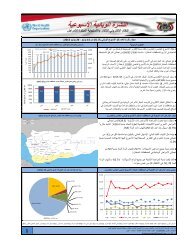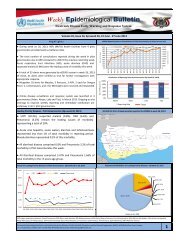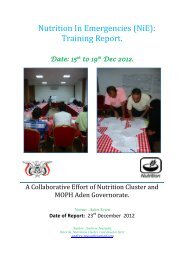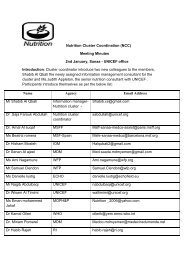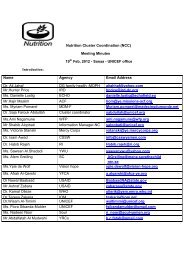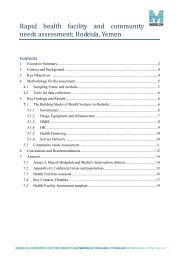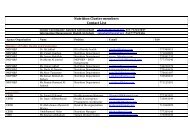Download - Yemen Humanitarian Response | YEMEN
Download - Yemen Humanitarian Response | YEMEN
Download - Yemen Humanitarian Response | YEMEN
Create successful ePaper yourself
Turn your PDF publications into a flip-book with our unique Google optimized e-Paper software.
Teams attempted to collect data from 20 households per cluster. All chosen households wereselected to answer the household and mortality questions, whether or not they contained achild 6–59 months of age. If household members were not present during the survey, the teamrevisited the household at least three times in an effort to interview and measure eligiblehousehold members, unless security or logistical constraints prohibited the amount of timespent in a cluster. In situations where the members of a household had departed permanentlyor were not expected to return before the survey team had to leave the cluster, that particularhousehold was skipped and not replaced. The minimum age of respondents for interview was15 years old. When respondents could not provide accurate information, households wererevisited and if accurate information could not be obtained, those questions were marked asmissing in the questionnaire. All eligible children aged 6 to 59 months were measured in thecluster. If a child’s age was unknown, it was estimated using a seasonal/local calendar. Absentchildren were followed up during the survey day. Children present the day of the survey, butwho are not living in the household are not included in the survey.3.5. Training and survey team compositionSix teams were trained for the survey and each team consisted of 4 members – two femalemeasurers and one female interviewer and one male team leader were recruited, trained andsubsequently participated in the data collection and conduct of the survey. Females collectedinformation from the mothers/care takers’ and conducted weight and height measurements ofthe children. Male members carried the instruments, arranged and helped in anthropometricmeasurements and conducted the sampling at each cluster. The training of team members(interviewers, measurers and team leaders) by the survey consultant and manager wasconducted at Al-houta for 4 days.More than half of the training sessions focused on anthropometric measurement and eachsurveyor had to practice both in the classroom and in the community before qualifying to jointhe team. Adequate attention was given in training on standardizing the instrument and keeprecord of the procedure and variation or error (if any). The team was trained on interviewtechniques, the format of questionnaires as well as on data recording and reviewingtechniques. The team leaders were trained for editing the questionnaires in the field and inquality assurance techniques. The training also covered basic introduction to nutrition such asdefinition of malnutrition, causes, classification and UNICEF framework, explanation on thesurvey and its methodology, and practical training on the important data collection procedures,anthropometric measurement techniques, recognition of the signs and symptoms ofmalnutrition including nutritional oedema.19




